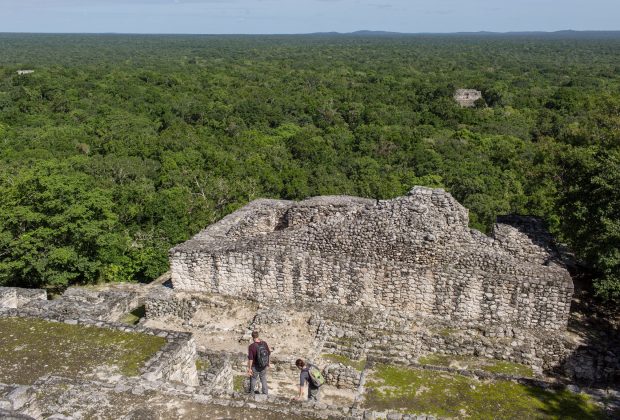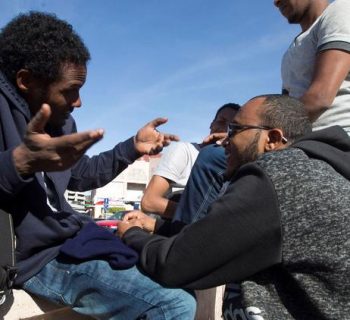By Michael Snyder ~ February 7, 2108 ~ NY Times
Of the nearly 1,000 registered archaeological sites scattered across the southeast Mexican state of Campeche, Xcalumkín is far from the most impressive. Just over 40 miles northeast of the state capital (also called Campeche), it looks, at first glance, like little more than a few half-excavated hillsides. On the stifling May morning that I visited, the scrubby forest was dry and radioactively bright, baked under a sky the color of a pilot flame. It didn’t take long for this abstraction of a city to come to life. Hills revealed themselves as pyramids. Fields became plazas. A cave opening suddenly in the ground — a tree, like an umbilical cord, growing from its center — became a reservoir.
I had come out that morning with Rubí Peniche Lozano, who runs a restaurant called Capuchino in the historic center of Campeche, an extravagantly pretty town on the west of the Yucatán Peninsula. She’d brought along her sister, Ada, a local teacher, and Lirio Suarez Améndola, a former delegate for the National Institute of Anthropology and History, or I.N.A.H.

Ms. Suarez walked us through the site, pointing out the hidden mouths of cisterns and offering I.N.A.H.’s best guesses as to what each structure might have been. Xcalumkín, she told us, had likely existed since the beginning of the millennium but, like most settlements in this part of the peninsula, would have flourished between the 8th and 10th centuries, part of a vast network of city-states and vassal towns that made up the classical Maya world. By 950 A.D., that world had all but disappeared.
“To make the stucco they used to cover the buildings and pave the roads, they needed charcoal, so imagine how many trees they needed,” she said as we looked down into the reservoir that was now a cave. “They emptied their water sources, cut down all their trees. The temperature raised two degrees. They changed the climate completely.” She sounded almost exasperated. “Lots of people look at the Maya very romantically, that they lived with nature and all that, but it’s not true. They were just like us: human beings.”

We had reached Xcalumkín by driving north along the modern highway that connects Campeche to Mérida in the neighboring state of Yucatán, following the route of the Camino Royal, or Royal Road, built for the visit of Mexico’s short-reigning Hapsburg Empress Carlota in the late 19th century. We stopped at Kankí and Acanmul, a pair of ruins that, despite lying just off the highway, receive almost no visitors. In the pretty colonial backwater of Hecelchakán, we ate breakfast at an enormous rotunda-like taco stand in the central plaza, famous enough not to require a name. For four generations and 40 years, the family that runs the place has turned out Campeche’s best cochinita pibil, a dish of adobo-rubbed pork roasted in an underground oven, and relleno negro, an ashy stew of ground turkey and pork stained black with charred chilies. Most days, they run out of cochinita by noon and relleno negro even earlier.
The afternoon would take us to artisan towns like Dzitbalchén, known for its embroidered blouses, and Bécal, where Mexico’s finest panama hats are woven from hair-thin lengths of palm in damp underground caves. The whole day, we didn’t pass a single other traveler. Despite its pastel-hued jewel-box of a capital, its rich archaeological history, a clutch of top-notch hotels and food to compete with anything on the peninsula, Campeche remains mercifully lost to tourism.

Campeche’s star attraction should be the ancient Maya city of Calakmul, once the most powerful city-state in the classical Maya world, now an immense archaeological site buried deep in the wild southern jungles of the 2,800-square-mile Calakmul Biosphere Reserve. But while Chichen Itza and Tulum, in the neighboring states of Yucatán and Quintana Roo, attract as many as 5,500 visitors per day, Calakmul draws barely 100. When I came down to Campeche for the first time in February 2017 (a relatively cool, dry month in Mexico’s tropical south) Calakmul is what I came to see.
From the early 10th century until the late 1920s, when, according to the oral tradition of the local rubber tappers, an American prospector spotted the site from a low-flying plane, Calakmul was lost to time and memory (its presence was officially registered by I.N.A.H. in 1931). For the next 50 years, the rubber tappers working in the forest chipped the narrative glyphs from the city’s monolithic steles, selling the city’s recorded history one piece at a time. Excavations didn’t begin in earnest until the 1980s.

To reach Calakmul, I drove four hours down well-paved roads, booby-trapped with ill-marked speed bumps, stopping en route at El Cachimbazo, a seaside restaurant in the town of Champotón, for a lunch of ceviche and Campeche’s unofficial state dish, pan de cazón (layers of tortilla and shredded shark bathed in tomato purée, jauntily capped with a whole habanero).
At the entrance to the Calakmul Biosphere Reserve, I dropped my things at a serene eco-lodge called Puerta Calakmul, by far the best hotel in the area (high-season rates start at $175), and crossed the road to see the exquisitely preserved stucco frieze at Balamku, one of many smaller archaeological sites in the area. At sundown, I drove five minutes down the road to watch millions of bats spill from the mouth of a hidden cave and spiral skyward. At dawn the next day, I woke to the call of howler monkeys and drove the last 90 minutes through the park to the site itself.

On the way, I picked up my guide, Manuel Pech, who has lived most of his life in the nearby village of Conhuas. He had returned a year before from the capital, where he’d studied biology, “because,” he told me, “I wanted to save the world.” Growing up next to ruins, he seemed to view civilizational collapse as imminent rather than hypothetical.
Mr. Pech and I spent well over three hours at Calakmul that morning, wandering among the lost foundations of untold buildings. At the ceremonial center, we climbed a flight of steep stone stairs to the summit of the highest pyramid. Fifteen hundred years ago, kings and priests would have performed their ceremonies here — coronations, perhaps, or sacrifices, though no one knows for sure — looking out over a city of 50,000 people with stucco-paved roads, called sakbe, radiating out from its center.

My view was different. Jungle extended infinitely in every direction. To the south, Guatemala. To the north, the horizon undulated like heat. “Those hills out there,” Mr. Pech said, “we don’t know which are just hills and which are pyramids that we haven’t uncovered yet.” The only signs of human life were the peaks of Calakmul’s two other great pyramids bursting through the canopy like mountains through clouds.
I left Calakmul the following day and drove east, stopping at Becán, where a series of interconnected plazas and public buildings suggest the shape of quotidian Maya life, and at Chicanná, once Becán’s aristocratic suburb, now another abandoned stone settlement in the forest, where heavily ornamented mansions reveal a world as stratified as our own. At Xpujil — the last of the ruins along the highway, roughly 40 minutes from Puerta Calakmul by car — I turned north along a recently paved two-lane road and through 40 miles of forest, virtually uninterrupted by human settlement. The trees along the roadside were more chartreuse than green. Swarms of butterflies ferried between them like they had places to go.

The scenic route took me through languid towns like Dzitbalché and Iturbide, and to beautiful, lonely ruins at Dzibilnocac and Hochob, elaborately carved in an architectural style known today as “Chenes,” which Mr. Suarez would later describe as “Maya Baroque.” About 25 miles before Campeche, I stopped at Edzná, whose carefully reconstructed galleries, pyramids and open plazas rival Calakmul’s in grandeur. A short distance from Hacienda Huayamon — Campeche’s most luxurious hotel, housed in the restored remains of an 18th-century plantation — Edzná is Campeche’s most popular archaeological site. Even still, on the day I visited, there were more iguanas than people. When I reached Campeche that evening, I settled in at the Hacienda Huayamon’s sister hotel, Hacienda Puerta Campeche,just inside the city walls (rates in high season start at $418).
Like most haciendas in the Yucatán, Huayamon — a 20-minute drive from the city — was founded in the 18th century (although most of its buildings date to the 19th century) to cultivate and process henequen, a tough fiber made from a variety of agave. Starting in 1870, the buildings that now house Puerta Campeche served as Huayamon’s warehouse and a shop selling everything from imported wines to lentils to rubber from the southern forests. Both are relics of the city’s 19th-century decline, a reminder of where the word decadence comes from.
By the time henequen had become the Yucatán’s economic mainstay, most trade had shifted away from Campeche to the newly built port of Progreso — or Progress — on the peninsula’s northern coast. For the previous three centuries, Campeche, Mexico’s second-oldest port, had thrived at the periphery of law. Though just two hours from Mexico City by plane, Campeche was, in those days, far from the centers of colonial power and virtually ungovernable. When I met Ms. Peniche’s husband, the local historian Alejandro MacGregor Gonzalez, he told me, “contraband was this city’s glory!”
He had asked me to join him for breakfast at a no-frills storefront on the Parque Santa Ana, a charming plaza just outside the city walls. He ordered us ice-cold bottles of sweet black tea and two trancas de lechón, the Taquería del Parque’s specialty. The tea, he explained, combined Campeche’s first colonial cash crop, sugar cane, with black tea that came in on British pirate ships in the 16th century. The trancas were sandwiches of lechón, a Creole roast pork dish from the Caribbean, served on crusty lengths of bread introduced by French corsairs.

“That food is very Yucateco,” he said, pointing across the street to Taquería Hecelchakán, which trucks in cochinita from the town of the same name each morning. “This is very Campechano. Our whole culture is mixed!” Elsewhere in Mexico, the word campechano is usually used in the context of food and means just that — mixed — as in a campechano taco, made with meat and sausage, or a campechano ceviche, made with shrimp and octopus and whatever else is on hand.
For the rest of the day, Mr. MacGregor showed me around the elegantly restored old quarter center of his hometown and its northern and southern edges, where the peaceful streets give way to mangroves and scruffy urban beaches. He told me about centuries of pirate attacks and the city walls — the last of their kind in Mexico — built to fend them off. He told me how his own ancestors, Scottish privateers, had arrived here in the 17th century via Charleston. We drank beers on the tranquil malecón and watched cormorants dive low over the water. The name Campeche, he explained, derives from the words kaam, meaning mirror, and pech, meaning birds in the near-extinct local dialect of Maya. “Campeche is literally ‘a mirror for the birds!” he said. I’ve never known someone to speak with so many exclamation points.

That evening, I walked along quiet cobbled streets past candy-colored houses where old men and women sat out on the sidewalks to play cards and gossip. For dinner, I ate tamales and drank coconut horchata, slushy and sweet as a milkshake, at the open-air Portales de San Martín just outside the old city walls (there are several small restaurants, or antojerías, located in the Portales, all serving more or less the same food). I tried to imagine the city’s bloody, lawless past, but the image wouldn’t materialize. If Campeche today is one of the safest places in Mexico, it’s in part because, Mr. MacGregor told me, “we had 200 years of piracy, fear and violence. We’re not interested in all that now.” Pirates and traders, an empirical fact of a knowable past, seemed more remote and fantastic than a Maya world conjured from stone and dust.
I had come back to Campeche, despite warnings about the May heat, to see an archaeological site that Mr. Pech had told me about, not far from Calakmul. His grandfather, he told me, had uncovered it back in 1950 during his youth as a rubber tapper (nearly all the ruins around Calakmul were found this way, though there are no records to confirm these stories). The first archaeologist officially entered the site in 1993, guided by Mr. Pech’s grandfather, and although I.N.A.H. spent a year restoring it in 2001, they soon abandoned it to the forest. They called the place Nadzcaan — Maya for Closer to the Sky.
Nadzcaan isn’t technically open to the public, but the only real restriction on getting there is stamina. Set about nine miles back from the road, it’s accessible either on foot, a three-hour hike through the forest, or by motorbike (40 minutes plus a half-hour trudge on a gradual incline). Walking in, we passed iridescent wild turkeys and the fresh tracks of feral pigs. A troop of spider monkeys high up in the trees shook branches to scare us off. Eventually, Nadzcaan emerged coyly from the forest, the 130-foot pyramid at its center dissolving into the trees like the memory of a dream.
That night we camped on top of the pyramid. I asked Mr. Pech what the Maya would have used this place for. He dragged a finger across his throat. “Sacrifice probably,” he said, “but we never really know.” The best we can do is guess what this world once looked like and how it all came crashing down.
As the sun set, I looked out over the forest. Howler monkeys called from the distance. Cicadas chirred. A blood moon rose slowly into a bank of clouds and emerged, a half-hour later, washed clean. Mr. Pech smiled. “It’s like a mirror,” he said.
Source: Michael Snyder ~ February 7, 2108 ~ NY Times







